The Predator B, officially designated as the ‘Reaper,’ invites us to Explore the Best of General Atomics MQ-9 Reaper UAV, the world’s most advanced and formidable multi-role UAV. Specifically designed for long-endurance, high-altitude surveillance, reconnaissance, and strike missions, the MQ-9 sets a new standard in unmanned aerial capabilities.
It proudly holds the title of the first hunter-killer UAV meticulously crafted for extensive, uninterrupted surveillance in the skies above.
With an average unit cost estimated at $30 million in 2021 dollars, the MQ-9 showcases its unparalleled worth. The United States Air Force (USAF) boasts an operational fleet of over 300 MQ-9 Reapers as of May 2021, each representing the pinnacle of cutting-edge technology.
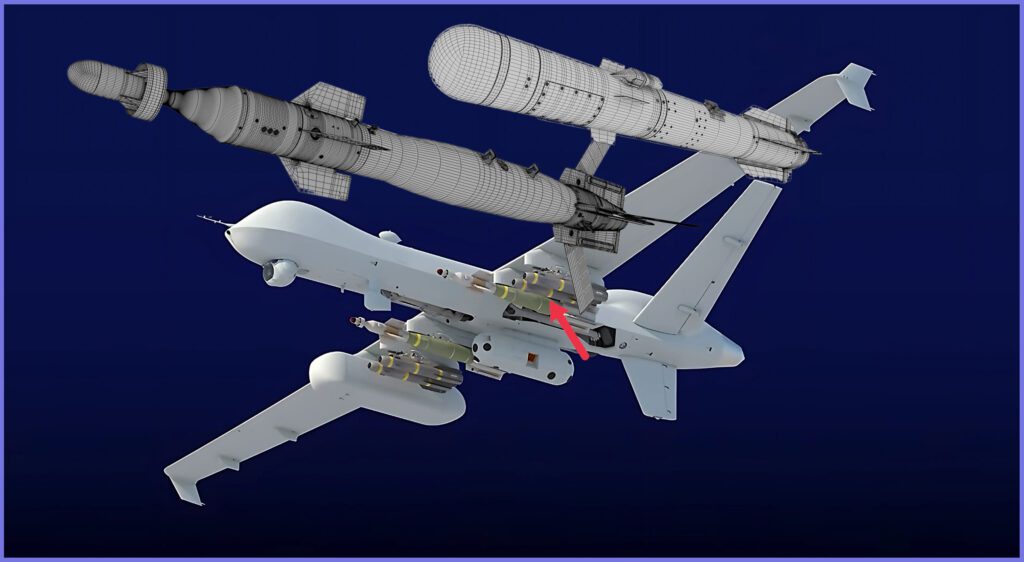
Numerous MQ-9 aircraft have undergone retrofitting with state-of-the-art equipment upgrades, further enhancing their performance in high-intensity combat scenarios. Rest assured, all new MQ-9s are equipped with these formidable upgrades.
Looking ahead, 2035 has been projected as the end of the service life for the esteemed MQ-9 fleet, marking a significant chapter in its illustrious legacy.
The turning point occurred when the Air National Guard 174th Attack Wing initiated a significant transition in 2008. They decided to replace their existing piloted F-16 fighters with the advanced MQ-9A Reapers. This transformation brought about a major shift in their operational capabilities, allowing them to leverage the advanced features and capabilities of the MQ-9A Reapers.

By adopting these state-of-the-art unmanned aerial vehicles (UAVs), the Attack Wing enhanced their reconnaissance, surveillance, and strike capabilities, ushering in a new era of unmanned combat aerial vehicle (UCAV) utilization within their unit.
This strategic decision proved to be highly cost-effective by reducing reliance on fighter aircraft sorties through the deployment of armed drones. Moreover, the extended duration of drone operations enables precise surveillance and targeted strikes.
This milestone marked the inaugural complete conversion of a fighter unit to the utilization of unmanned combat aerial vehicles (UCAVs). By March 2011, the U.S. Air Force prioritized training a greater number of pilots for advanced unmanned aerial vehicles, highlighting the escalating importance of this state-of-the-art technology.

The Reaper serves as a vital intelligence-collection asset and, secondarily, as a highly effective tool against dynamic execution targets.
With its exceptional loiter time, extensive range sensors, versatile multi-mode communications suite, and precision weaponry, the Reaper possesses a distinct capability to engage in strike operations, coordinate missions, and conduct reconnaissance against valuable, fleeting, and time-sensitive targets.
Notably, the U.S. Customs and Border Protection, along with numerous other country’s militaries, also employ the Reaper for diverse purposes. In comparison to its predecessor, the General Atomics MQ-1 Predator, the MQ-9 represents a larger, heavier, and more formidable aircraft that can be effortlessly controlled using the same ground systems.
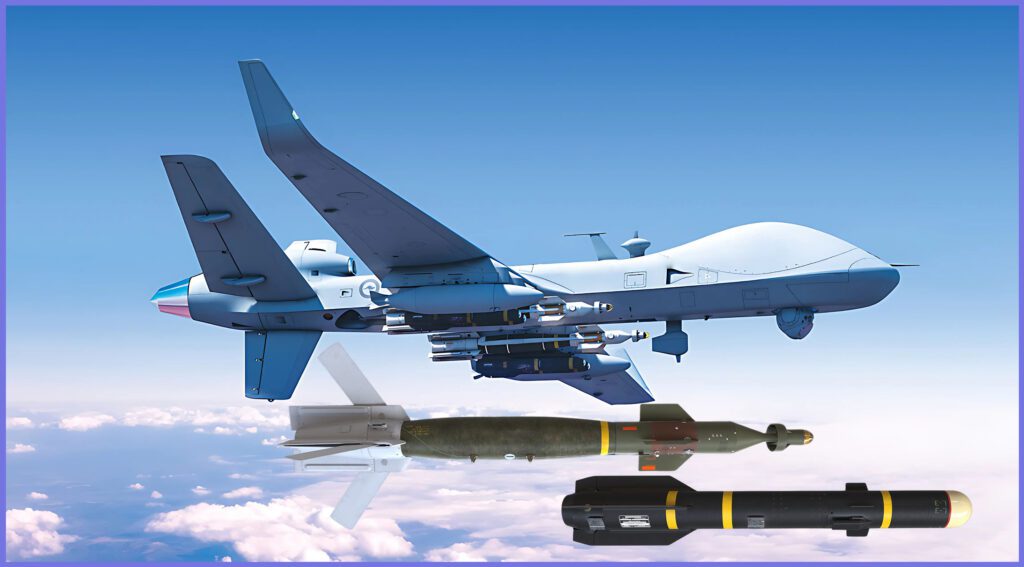
Equipped with a robust 900-shaft-horsepower (671 kW) turboprop engine (in contrast to the Predator’s 115 hp (86 kW) piston engine), the Reaper possesses significantly augmented power.
This capability enables the Reaper to carry an impressive payload of ordnance, approximately 15 times more than its predecessor while cruising at a speed nearly three times faster than the MQ-1. The aircrew stationed in the Ground Control Station (GCS) vigilantly monitors and controls the aircraft, including its weapon deployment activities.
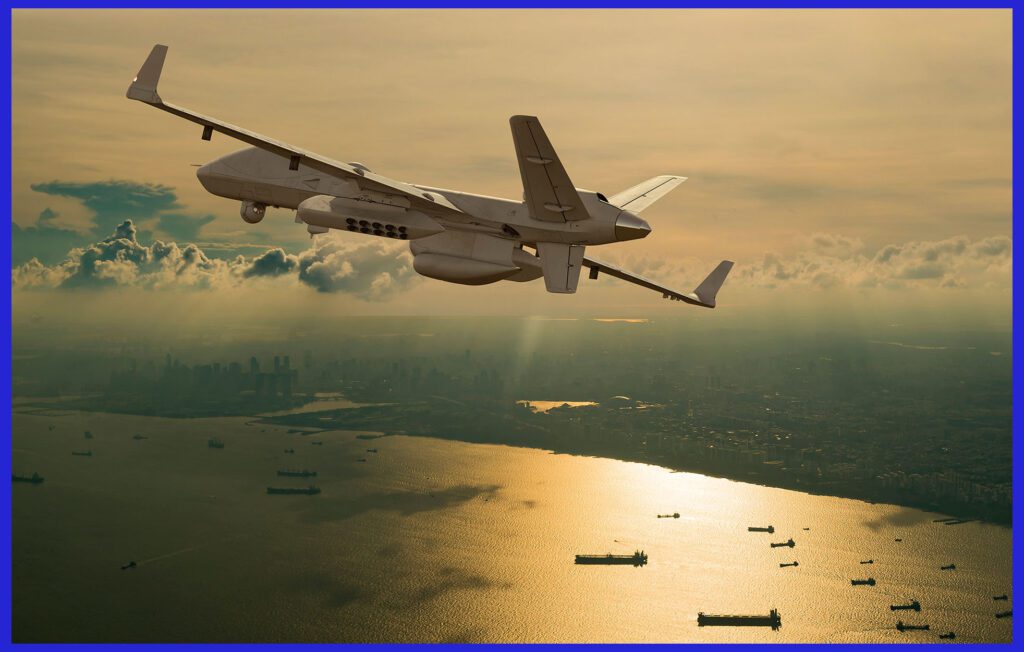
The Story Behind the Development of the General Atomics MQ-9 Reaper
The development of the General Atomics MQ-9 Reaper can be traced back to its predecessor, the General Atomics MQ-1 Predator. The journey began with the General Atomics “Predator B-001,” a proof-of-concept aircraft that took its first flight in early 2001. Abraham Karem considered the founding father and designer of the basic Predator, played a crucial role in its development.
The B-001 was equipped with an AlliedSignal Garrett TPE331-10T turboprop engine, providing 950 shaft horsepower (710 kW). Its airframe was based on the standard Predator design but featured an enlarged fuselage and lengthened wings, stretching from 48 feet to 66 feet.

The B-001 prototype of the General Atomics MQ-9 Reaper demonstrated impressive performance characteristics. It achieved a top speed of 410 km/h (250 mph) and could carry a payload of up to 750 pounds (340 kg) while flying at an altitude of 50,000 feet (15,000 m). With a remarkable endurance of 30 hours, the B-001 showcased its long-duration operational capabilities.
Following the successful development of the B-001, General Atomics introduced the subsequent version, known as “Predator B-002.” This upgraded model featured a jet-powered configuration, incorporating a Williams FJ44-2A turbofan engine that generated 2,300 lbf of thrust.
The Predator B-002 had a payload capacity of 475 pounds (215 kg) and a maximum operational ceiling of 60,000 feet (18 km). With an endurance of 12 hours, it offered improved performance capabilities compared to its predecessor.
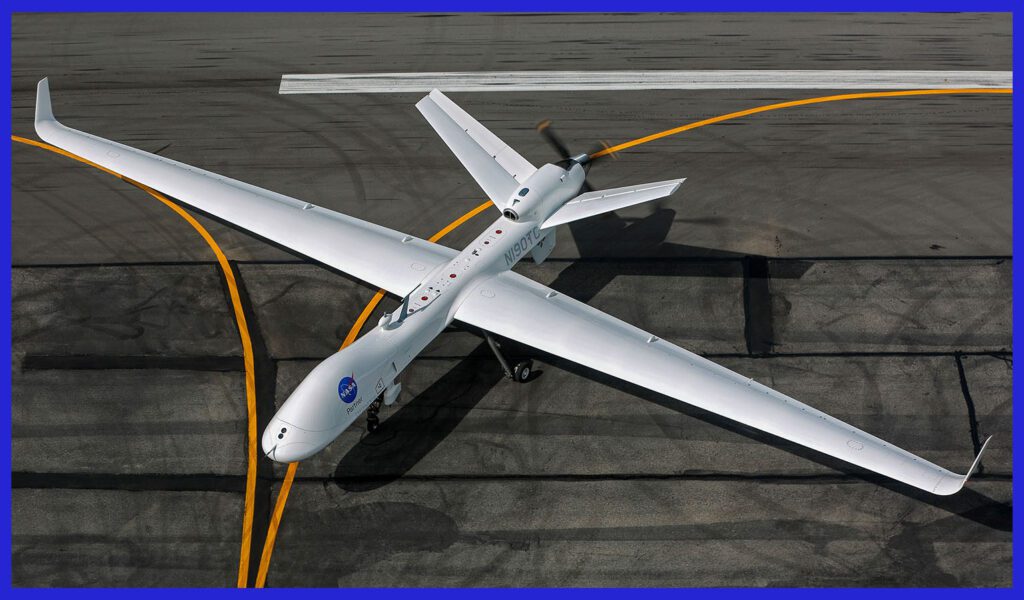
Both the B-002 and the B-003 aircraft were specifically commissioned by the U.S. Air Force (USAF) for the purpose of evaluation. In adherence to the given instructions, the B-002 underwent a significant modification wherein its jet engine was replaced with a turboprop engine.
This alteration was carried out to align with the desired long-endurance configuration requested by the USAF. By implementing this change, the USAF successfully acquired two aircraft that matched the desired configuration.
The subsequent variant, referred to as the “Predator B-003” or “Altair” by General Atomics, introduced a novel airframe boasting an 84-foot (26 m) wingspan, along with a takeoff weight of approximately 7,000 pounds (3,200 kg). Importantly, this new iteration still incorporated the use of the aforementioned turboprop engine, ensuring consistency in performance.

The B-003 variant demonstrated impressive attributes, including a payload capacity of 3,000 pounds (1,360 kg), a max height of 52,000 feet (16 km), and an endurance of over 36 hours.
Subsequently, it underwent a name change to “Reaper” at the behest of the USAF, symbolizing its augmented capabilities for persistent operations. Operating both day and night in combat zones, the Reaper diligently awaited target opportunities, serving as a cost-effective complement to piloted attack aircraft. It functioned as a continuous remotely piloted vehicle (RPV) under the guidance of ground controllers.
The development of the General Atomics MQ-9 Reaper denoted significant progress and design enhancements from the original Predator concept, yielding a highly adept and adaptable unmanned aerial vehicle.
Key aspects of the Reaper’s development included:
- Increased Payload Capacity: The Reaper was designed with a larger airframe and increased payload capacity compared to the Predator. This allowed for the integration of more sensors, cameras, and mission-specific equipment, as well as a greater number and variety of weapons such as Up to four AGM-114 Hellfire, two 500 lb (230 kg) GBU-12 Paveway II laser-guided bombs. Or The 500 lb (230 kg) GBU-38 Joint Direct Attack Munition (JDAM). Air-to-Air Stinger (ATAS).
- Extended Endurance: One of the primary objectives of the Reaper’s development was to enhance its endurance capabilities. By incorporating more efficient engines and increasing fuel capacity, the Reaper was able to stay airborne for significantly longer durations compared to the Predator.
- Higher Altitude Operations: The Reaper was designed to operate at higher altitudes, up to 50,000 feet, providing better situational awareness and avoiding most air defence systems. This capability allowed the Reaper to conduct its missions with increased safety and effectiveness.
- Improved Communication and Data Link: The Reaper featured advanced communication systems and data links to facilitate the real-time transmission of mission data and command and control capabilities. These enhancements enabled seamless integration into joint operations and coordination with other military platforms.

Design Analysis of the General Atomics MQ-9 Reaper
The design of the General Atomics MQ-9 Reaper, also commonly referred to as the Predator B, integrates several pivotal elements that significantly enhance its operational effectiveness and overall performance.
In essence, a standard MQ-9 system encompasses a multitude of components, such as multiple aircraft, a ground control station, advanced communications equipment, essential maintenance spares, and a dedicated team of highly skilled personnel.
This proficient military flight crew comprises a proficient pilot, a proficient sensor operator, and a proficient Mission Intelligence Coordinator, each fulfilling crucial roles. Now, let’s delve into a comprehensive analysis of its remarkable design features:
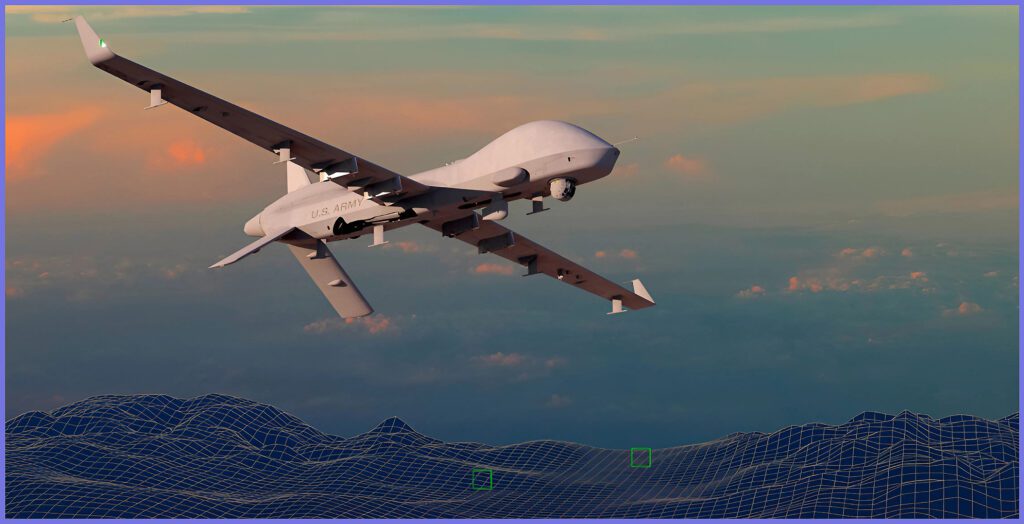
Airframe and Dimensions: The MQ-9 Reaper showcases an elegant and sturdy airframe, carefully constructed primarily using composite materials. These materials not only deliver remarkable strength but also effectively reduce the overall weight, achieving an exceptional balance.
Measuring approximately 36 feet (11 meters) in length, with a wingspan spanning about 66 feet (20 meters) and a height of around 10 feet (3 meters), the Reaper possesses dimensions that perfectly accommodate its diverse payloads and weapons, while simultaneously ensuring flight stability and manoeuvrability.
A significant milestone occurred in January 2012 when General Atomics introduced a revolutionary design enhancement for the Reaper’s main landing gear, featuring trailing arms.
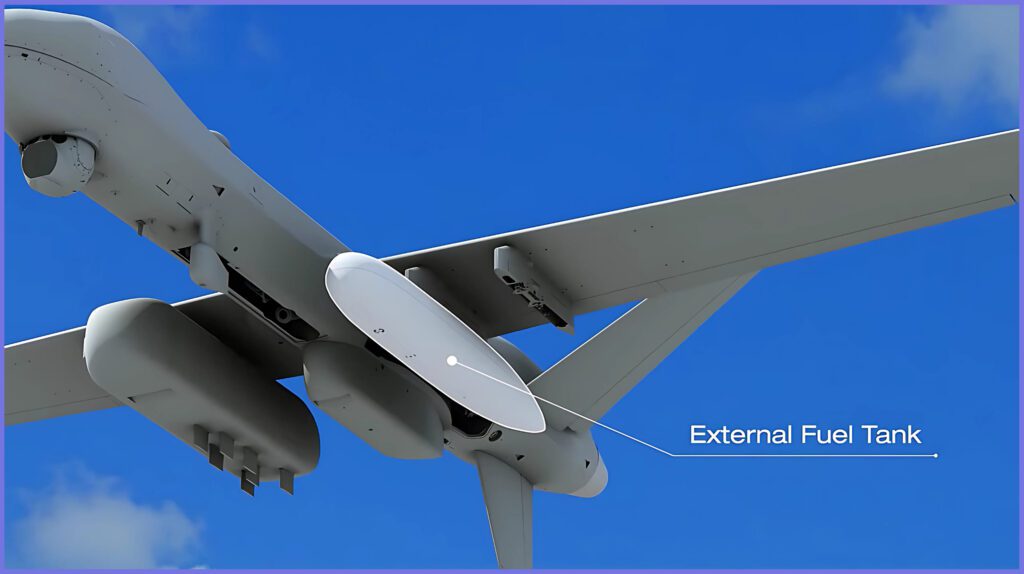
This innovative modification offers a wide range of advantages, including an impressive increase of over 30% in landing weight capacity and a notable 12% augmentation in gross takeoff weight. This enhancement elevates the weight capacity from 10,500 pounds (4,763 kg) to 11,700 pounds (5,307 kg).
Furthermore, this ingenious design incorporates a shock absorber that requires no maintenance, eliminating the necessity for nitrogen pressurization. Additionally, a fully rejected takeoff brake system has been integrated, and provisions have been made to enable automatic takeoff and landing capability, as well as Anti-lock Brake System (ABS) field upgrades.

High Aspect Ratio Wings: The Reaper’s wings boast a high aspect ratio, signifying their elongated and slender nature in comparison to their width. This particular design characteristic significantly enhances the aerodynamic efficiency of the aircraft, allowing it to achieve optimal performance at higher altitudes and speeds.
Moreover, the high aspect ratio wings contribute substantially to the aircraft’s improved endurance and extended range capabilities. With an impressive wingspan of 66 ft (20 m) and a maximum payload capacity of 3,800 lb (1,724 kg), the MQ-9 can be equipped with a diverse array of armaments, including Hellfire missiles and laser-guided bomb units.
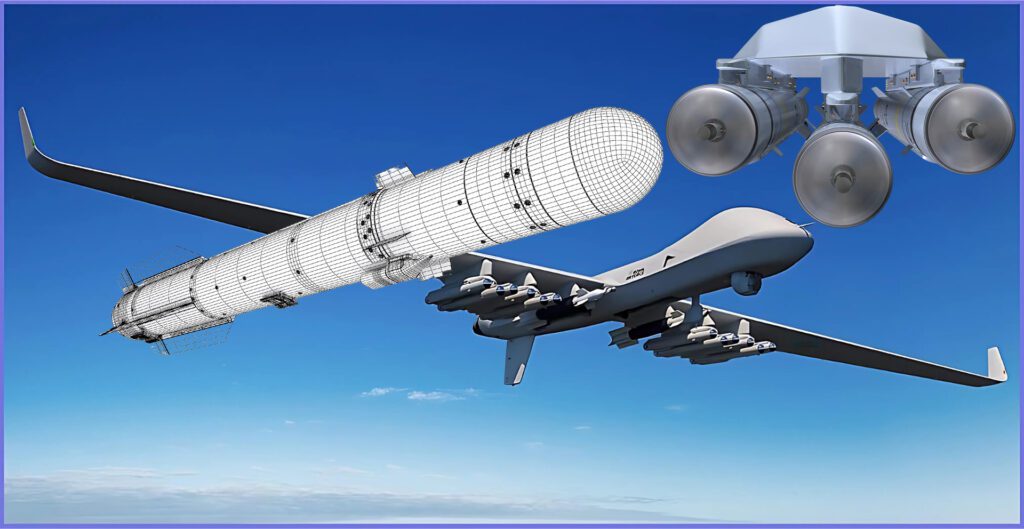
During ISR (Intelligence, Surveillance, and Reconnaissance) missions, the Reaper demonstrates an impressive endurance of over 30 hours, which slightly decreases to 23 hours when carrying a full weapons load.
Notably, the Reaper boasts a remarkable operational range of 1,150 mi (1,850 km) and an operational altitude reaching up to 50,000 ft (15,240 m), rendering it exceptionally valuable for prolonged loitering operations, encompassing both surveillance tasks and ground troop support.
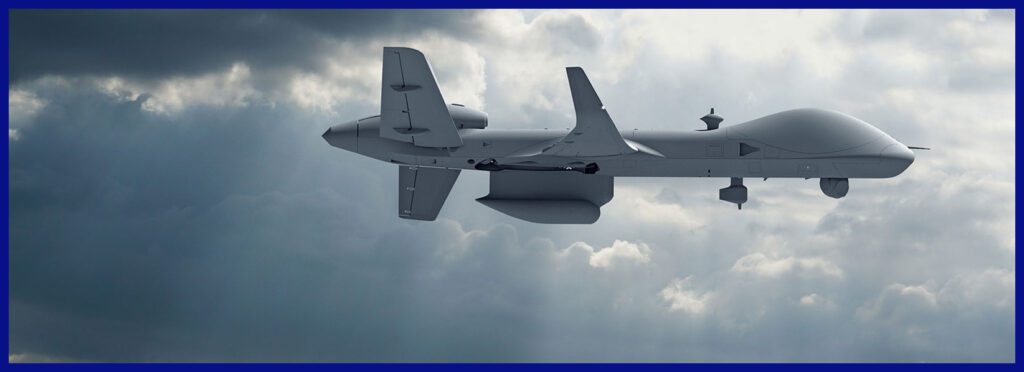
Extended Winglets: The Reaper is equipped with extended winglets at the tips of its wings. These winglets help reduce drag and improve fuel efficiency by reducing the aircraft’s induced drag and improving its lift-to-drag ratio. The winglets also enhance the Reaper’s stability and control during flight.
Engine Performance: The Reaper is propelled by a Honeywell TPE331-10 turboprop engine, renowned for delivering the essential thrust required for sustained flight and high-altitude operations. The engine’s exceptional reliability and fuel efficiency play a pivotal role in augmenting the Reaper’s impressive long-endurance capabilities.
Specifically, this drone is equipped with a robust 950 horsepower (710 kW) turboprop engine, enabling it to achieve a maximum speed of approximately 260 knots (482 km/h; 300 mph), with a cruising speed reaching up to 170 knots (315 km/h; 196 mph).
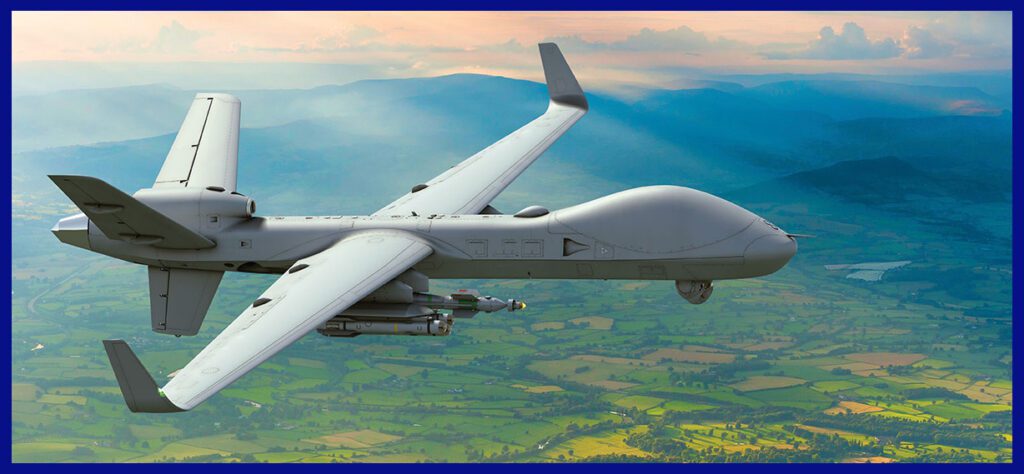
Payload Bay and Hardpoints: The Reaper has external hardpoints and an internal payload bay for attaching sensors, cameras, and mission-specific equipment. The hard points allow for external store attachment, such as guided missiles and explosives, while the internal bay stores mission kits.
The MQ-9 can adopt various mission kits and payload configurations to meet combat needs, including weapons and sensors. Its multi-spectral targeting sensor suite includes a colour/monochrome daylight TV, infrared capabilities, and an image-intensified TV for target designation in laser-guided munitions.
Equipped with the Lynx Multi-mode Radar, featuring ground moving target indication (GMTI) and synthetic aperture radar (SAR) in both spotlight and strip modes, the Reaper adapts to diverse mission requirements, including surveillance, reconnaissance, and precision strike missions.

Sensor Suite: The MQ-9 Reaper is equipped with a sophisticated sensor suite, which includes a multi-spectral targeting system (MTS). The MTS integrates infrared and electro-optical sensors, granting the Reaper the capability for day and night surveillance as well as target acquisition.
Moreover, the Reaper is equipped with a wide-area surveillance sensor system, incorporating the use of ARGUS-IS (Autonomous Real-Time Ground Ubiquitous Surveillance Imaging System).

ARGUS-IS is an advanced camera system that utilizes hundreds of cameras arranged in a mosaic to deliver uninterrupted video coverage and automated tracking of all moving objects within a square area of 100 km2 (39 sq mi).
This system, which attained its initial operating capability (IOC) in early 2014, is composed of 368 cameras, with each camera capable of capturing five million pixels, thereby producing an image comprised of roughly 1.8 billion pixels.
The video is recorded at a rate of 12 frames per second, resulting in the generation of several terabytes of data per minute.

Communication and Data Link: The Reaper features advanced communication systems and data links, including line-of-sight and beyond-line-of-sight capabilities. These systems facilitate the real-time transmission of mission data, command and control, and coordination with ground control stations and other assets.
Autonomous Capabilities: The MQ-9 Reaper has autonomous features that contribute to its operational efficiency. It is capable of autonomous takeoff and landing, as well as autonomous waypoint navigation, reducing the workload on operators and enabling autonomous operations in certain scenarios.
Overall, the design of the MQ-9 Reaper combines aerodynamic efficiency, payload flexibility, and advanced sensor capabilities to provide a versatile and effective platform for long-endurance surveillance, reconnaissance, and strike missions. Its design elements contribute to its operational success and enable it to adapt to a wide range of mission requirements.

Variant Configurations: Exploring the Different Versions of the General Atomics MQ-9 Reaper UAV
The General Atomics MQ-9 Reaper UAV, being a versatile platform, has undergone several variant configurations to fulfil different mission requirements and cater to specific operational needs. Here are some notable versions and variant configurations of the MQ-9 Reaper:
MQ-9A Reaper: The MQ-9A represents the standard version of the Reaper, designed primarily for intelligence, surveillance, reconnaissance (ISR), and strike missions. It is equipped with a diverse array of sensors and cameras, including an advanced multi-spectral targeting system (MTS), synthetic aperture radar (SAR), and other payloads tailored to specific mission requirements.
The MQ-9A can deploy various munitions, such as laser-guided bombs and Hellfire missiles, enabling effective engagement of ground targets.

The MQ-9A Extended Range (ER) variant was later introduced, featuring field-retrofittable enhancements like wing-borne fuel pods and a reinforced landing gear system. These improvements significantly extend the aircraft’s already impressive endurance from 27 hours to 34 hours, thereby enhancing its operational flexibility.
Notably, the MQ-9A has been procured by esteemed entities including the U.S. Air Force, the U.S. Department of Homeland Security, NASA, the Royal Air Force, the Italian Air Force, the French Air Force, and the Spanish Air Force.
MQ-9B SkyGuardian: The MQ-9B SkyGuardian represents a certified variant of the Reaper that has been meticulously developed to comply with the stringent standards of civil airspace certification. It incorporates numerous enhancements compared to the MQ-9A, encompassing increased fuel capacity, reduced maintenance requirements, and an improved structural design.
The SkyGuardian is specifically engineered for extended-range operations, capable of flying over the horizon via satellite for durations exceeding 40 hours, regardless of weather conditions.

Furthermore, it has been designed to seamlessly integrate into civil airspace, allowing joint forces and civil authorities to benefit from real-time situational awareness, both day and night, across any location worldwide.
With its ability to operate within non-segregated airspace, the MQ-9B is well-suited for diverse civil and governmental applications, including border surveillance and disaster response initiatives.
MQ-9B SeaGuardian: The SeaGuardian stands as a maritime surveillance variant derived from the MQ-9B SkyGuardian. It is specifically tailored to meet the unique demands of maritime operations, encompassing coastal surveillance, anti-piracy missions, and maritime law enforcement.

The SeaGuardian shares a close kinship with the groundbreaking SkyGuardian remotely piloted aircraft system (RPAS) but has been skillfully missionized through the integration of “bolt-on/bolt-off” maritime sensors. This specialized configuration enables the SeaGuardian to effectively undertake its designated tasks.
Similar to the SkyGuardian, the SeaGuardian possesses the capability to fly over the horizon via satellite for durations exceeding 30 hours, subject to specific configurations and weather conditions.
Furthermore, it has been designed to seamlessly integrate into civil airspace, allowing joint forces and civil authorities to leverage real-time situational awareness within the maritime domain, regardless of the time of day.
The SeaGuardian incorporates advanced maritime radar, automatic identification system (AIS) receivers and other sensors precisely optimized for comprehensive maritime domain awareness.
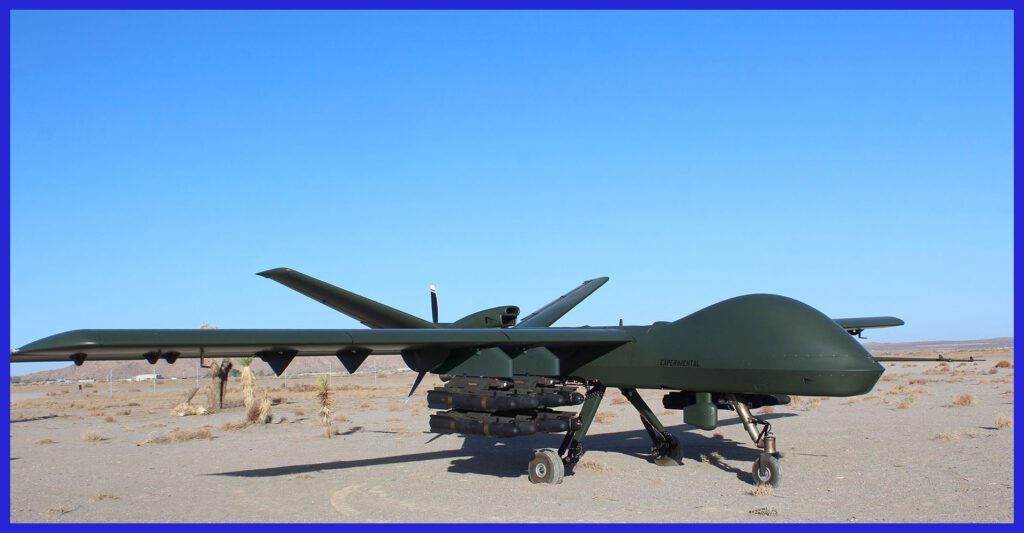
Mojave: Thanks to its short-takeoff and landing (STOL) capabilities from semi-improved runways, forward-basing operations can be conducted without the need for conventional paved runways or other infrastructure.
The Mojave can be controlled by the pilot through a conventional ground control station or a scalable command and control laptop system, and it has the flexibility to take off and land from numerous remote semi-improved areas.

This expands the range of employment opportunities, potentially including naval missions and sea-based support for special operations personnel, such as those based on aircraft carriers.
The avionics and flight control systems of the Mojave are built upon the pioneering designs and technologies of the MQ-9 Reaper. Furthermore, it features complete folding capabilities, enabling easy transportability via C-130 aircraft, and only requires four personnel for unfolding and activation.
With an unparalleled cargo capacity, it can carry twice as much as older aircraft models, allowing it to accommodate up to 16 AGM-114 Hellfire or similar missiles, weighing 3,600 lb (1,633 kg), due to its larger wing surface area.
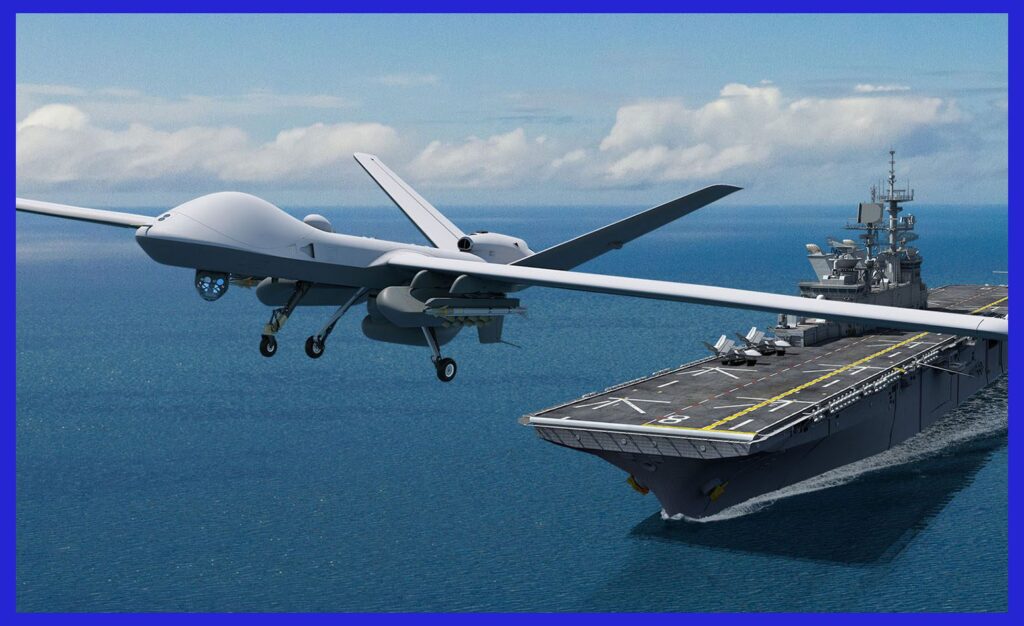
MQ-9B STOL: Designed for carrier-based operations, the MQ-9B STOL variant features a wing and tail kit that is modelled after the more compact Mojave system. This configuration enables the MQ-9B STOL to leverage the latest advancements in multi-domain surveillance and podded technologies while retaining its capability to execute complex, long-endurance missions.
One notable advantage of the MQ-9B STOL is its ability to conduct organic anti-submarine warfare and fleet defence missions without the requirement of landing at a conventional land-based airstrip for refuelling and maintenance.

Predator C Avenger: This is a new and advanced model of an unmanned aerial vehicle (UAV) developed by General Atomics Aeronautical Systems. With its sleek and cutting-edge appearance, the Avenger represents a significant leap forward in UAV technology and capabilities. It features a low-observable design that incorporates partial stealth elements to reduce its radar signature and enhance its survivability in hostile environments.
The inaugural flight of the Predator C took place in April 2009. The current production version boasts a larger wingspan of 76 feet and increased fuel capacity, resulting in an endurance boost of over 20 hours.

Equipped with a commercial Pratt & Whitney turbofan engine, the jet-powered drone can generate more than 5,000 pounds of thrust, allowing it to operate from runways as short as five kilometres. The engine is designed for superior fuel efficiency, leading the industry in terms of consumption.
The Avenger has a remarkable endurance of 20+ hours and can operate at altitudes exceeding 50,000 feet. Its massive wing hard points can accommodate multiple sensors, while the internal weapons bay has the capacity to hold 3,000 pounds of precision missiles or heavier sensor payloads.
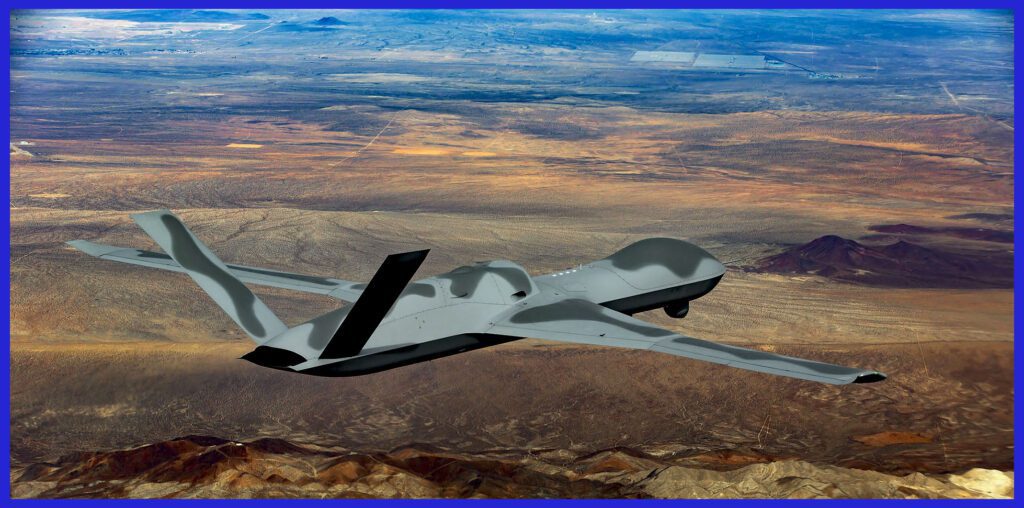
The Operational History of General Atomics MQ-9 Reaper:
The General Atomics MQ-9 Reaper has a well-documented operational history and has been extensively utilized by several military forces around the world. Since its introduction, the MQ-9 Reaper has been employed in various conflict zones and has played a crucial role in military operations.
- United States Air Force: The MQ-9 Reaper has been in operational service with the United States Air Force (USAF) since 2007. It has been primarily used for persistent intelligence, surveillance, and reconnaissance (ISR) missions, as well as for conducting precision strikes against ground targets. The Reaper has been extensively deployed in Afghanistan, Iraq, Syria, and other regions, providing critical situational awareness and conducting strikes against enemy forces and high-value targets.
- Other U.S. Military and Government Agencies: In addition to the USAF, other branches of the U.S. military and government agencies, such as the U.S. Navy, U.S. Homeland Security and the Central Intelligence Agency (CIA), have also utilized the MQ-9 Reaper for various missions. The U.S. Navy has employed the Reaper for maritime surveillance and target tracking, while the CIA has reportedly used the platform for intelligence gathering and targeted strikes.

- Counterterrorism Operations: The MQ-9 Reaper has been extensively employed in counterterrorism operations, particularly against militant groups such as ISIS and Al-Qaeda. Its long endurance, advanced sensors, and precision strike capabilities have made it a valuable asset in tracking and neutralizing high-value targets in remote and hostile environments.
- Usage by NASA: While the General Atomics MQ-9 Reaper is primarily known for its military applications, NASA (National Aeronautics and Space Administration) has also utilized the Reaper UAV for specific research and scientific missions. NASA has leveraged the capabilities of the Reaper to support various scientific investigations and conduct experimental flights.

The General Atomics MQ-9 Reaper is Currently Being Utilized by Multiple Operators:
The MQ-9 Reaper has been successfully exported to numerous allied nations, empowering them to enhance and fortify their military prowess. Prominent countries, including the United Kingdom, Japan, Poland, Italy, France, Spain, Netherlands, and India, have strategically utilized the Reaper to bolster their combat capabilities, fortify border security, and execute critical missions.
These resolute international deployments have unequivocally demonstrated the unmatched versatility, unwavering effectiveness, and indomitable spirit of the Reaper across a multitude of operational contexts.
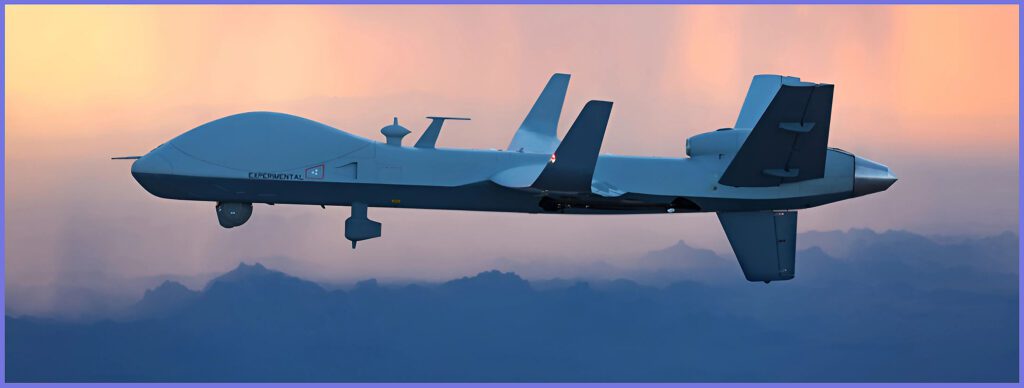
The General Atomics ‘MQ-9A’ Reaper Technical Specifications
- Crew: It is remotely operated and monitored by 2 ground control stations (GCS) crews.
- Length: 36 ft 1 in ( 11 m )
- Wingspan: 65 ft 7 in ( 20 m )
- Height: 12 ft 6 in ( 3.81 m )
- Empty Weight: 2,223 kg ( 4,901 lb )
- Max Takeoff Weight: 4,760 kg ( 10,494 lb )
- Fuel Capacity: 1,800 kg ( 4,000 lb )
- Payload: 1,700 kg ( 3,800 lb ) / Internal _ 360 kg ( 800 lb ) and External 1,400 kg ( 3,000 lb )
- Powerplant: 1 × Honeywell TPE331-10 turboprop, 900 hp ( 671 kW ) with Digital Electronic Engine Control ( DEEC ) enable

- Max Speed: 482 km/h ( 300 mph )
- Cruise Speed: 313 km/h ( 194 mph )
- Combat range: 1,900 km ( 1,200 mi )
- Endurance: 27 hours
- Service ceiling: 50,000 ft ( 15,420 m )
- Operational altitude: 25,000 ft ( 7.5 km )

- Armament: The MQ-9 Reaper is equipped with a total of seven hard points, with three located on each side of the wings. However, the centre stage pylon is not utilized for weapon systems but is instead designed to carry electronic countermeasure operations.
- The Reaper is capable of carrying various combinations of armaments, including up to four AGM-114 Hellfire air-to-ground missiles, or four Hellfire missiles along with two 500 lb (230 kg) GBU-12 Paveway II laser-guided bombs. Additionally, it has the capacity to carry the 500 lb (230 kg) GBU-38 Joint Direct Attack Munition (JDAM). Furthermore, the Reaper can also accommodate air-to-air Stinger (ATAS) missiles and the dual-mode Brimstone missile.

In conclusion, the General Atomics MQ-9 Reaper stands as a groundbreaking unmanned aerial vehicle (UAV) that has made a significant impact on military operations and scientific research.
With its advanced capabilities, including long endurance, versatile payload integration, and precision strike capabilities, the Reaper has proven its value in intelligence gathering, surveillance, and targeted engagements. Its operational history and widespread deployment worldwide underline its reliability and effectiveness in challenging environments.
Moreover, the Reaper’s utilization by NASA showcases its adaptability beyond military applications, contributing to scientific advancements and disaster response efforts. As a technological marvel, the MQ-9 Reaper continues to push the boundaries of unmanned aviation, shaping the future of aerial systems and their indispensable role in modern warfare and exploration.
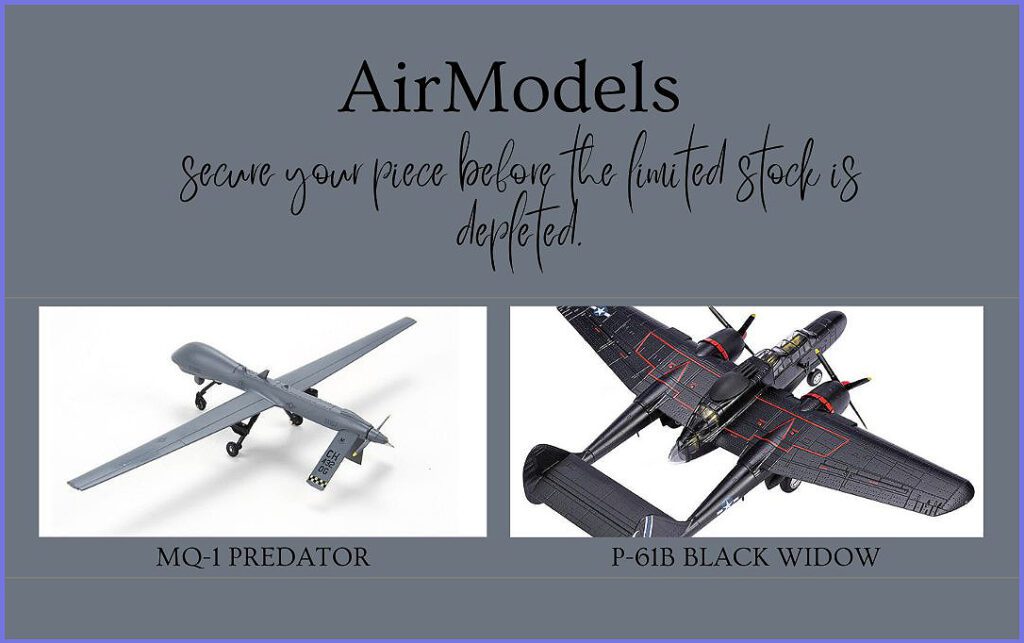
Important Announcement for Our Valued Readers!
After an article is published, updates or changes may have occurred beyond the time of publication. Therefore, it is important to be aware that certain information in the article might be outdated. To ensure the most accurate analysis, it is highly recommended to verify the content with the latest sources available.
However, we are dedicated to delivering outstanding articles on military products and global updates. Maintaining quality and smooth operation requires resources.
Your support sustains our efforts in providing insightful content. By purchasing high-quality products through our affiliated links, you help us keep our platform alive and acquire top-notch items. Your unwavering support is invaluable and inspires us to strive further.
We welcome your suggestions and requests for more information, as we value feedback from our readers. If there’s specific defence material or equipment not covered on our site, please share your request in the comments.
We’ll strive to research and provide the required information. We sincerely thank you for your unwavering interest in our website, and we eagerly anticipate hearing from you! Enjoy your reading experience!

3 thoughts on “Explore the Best of General Atomics MQ-9 Reaper UAV”